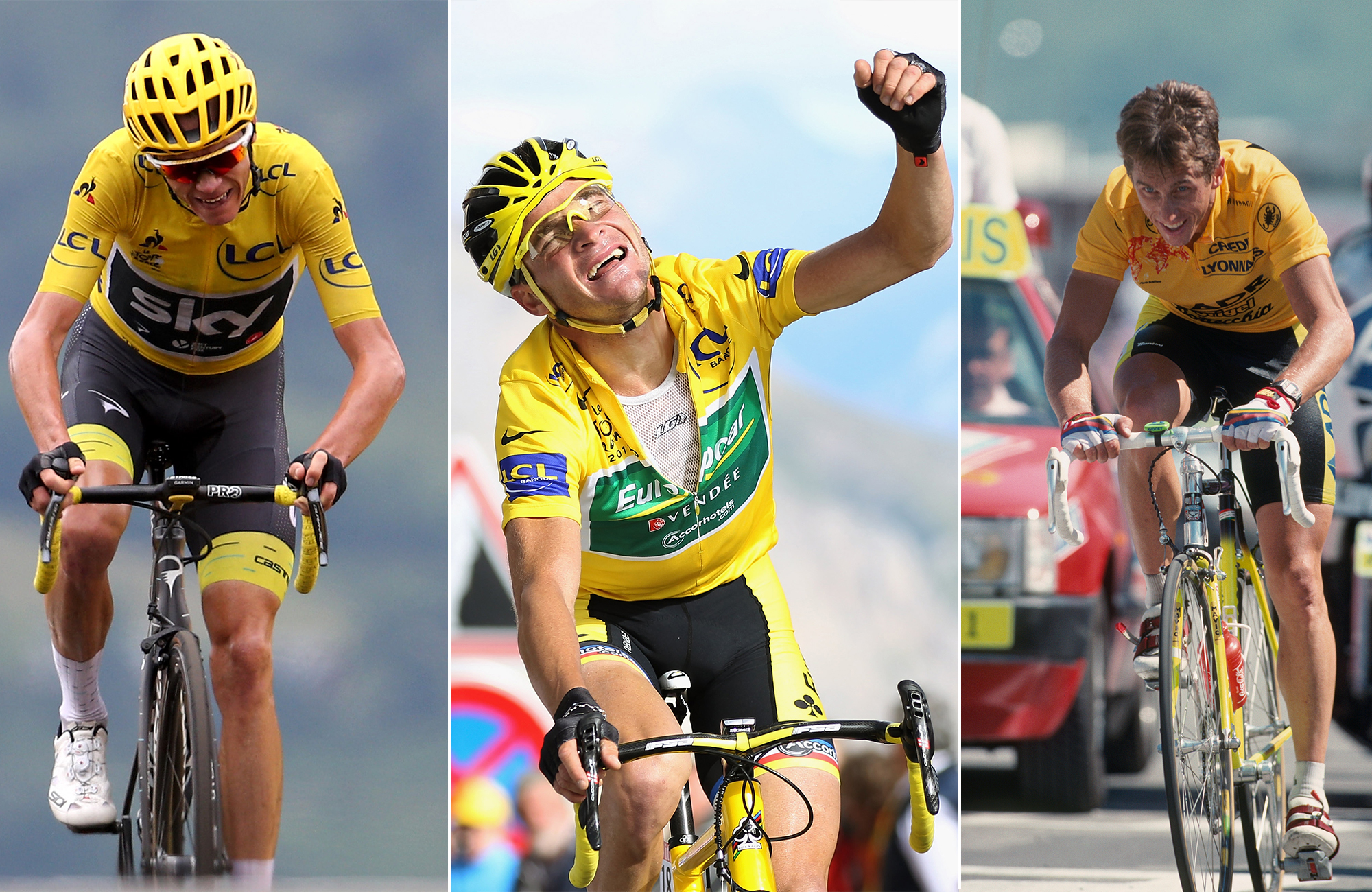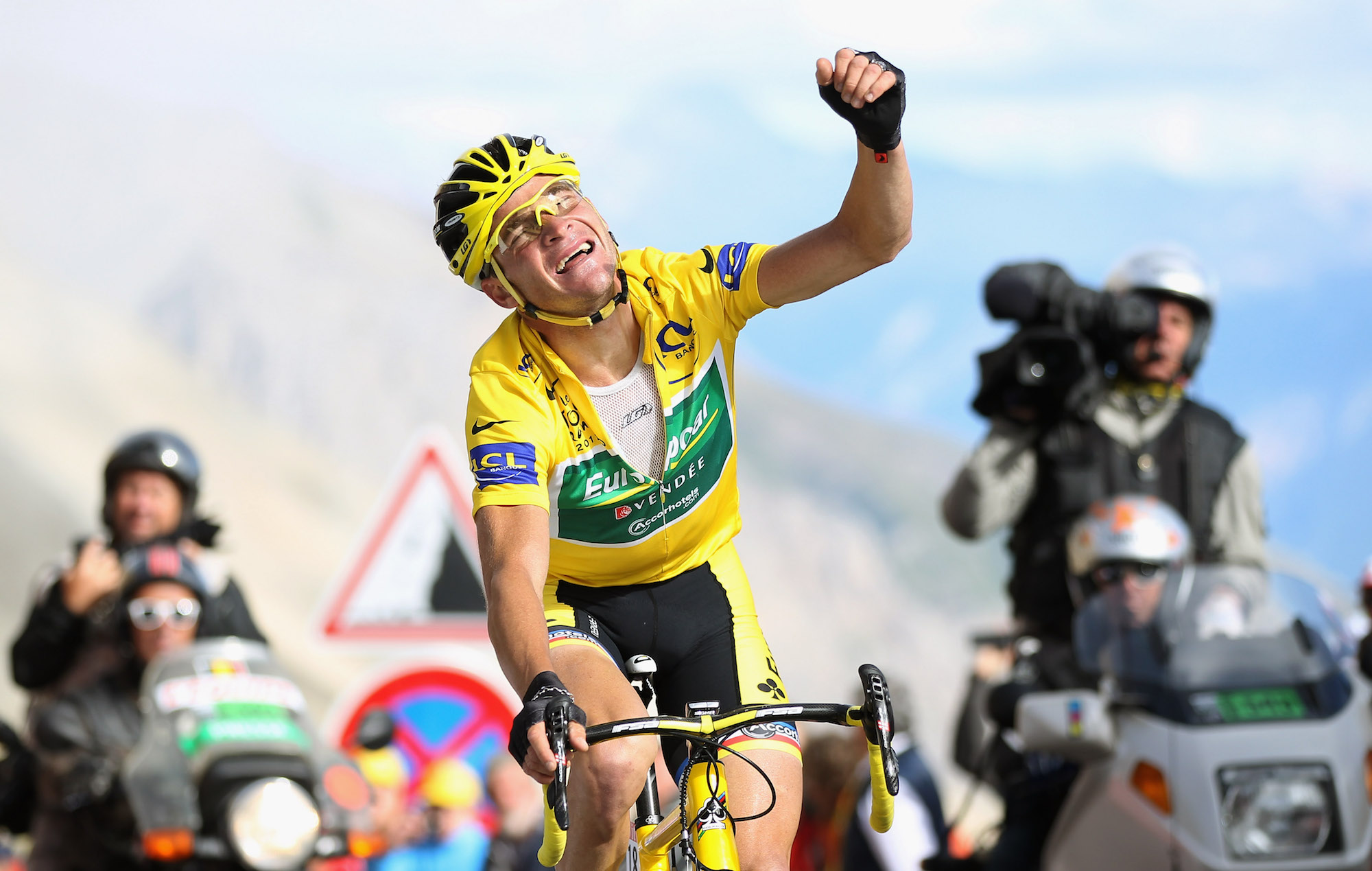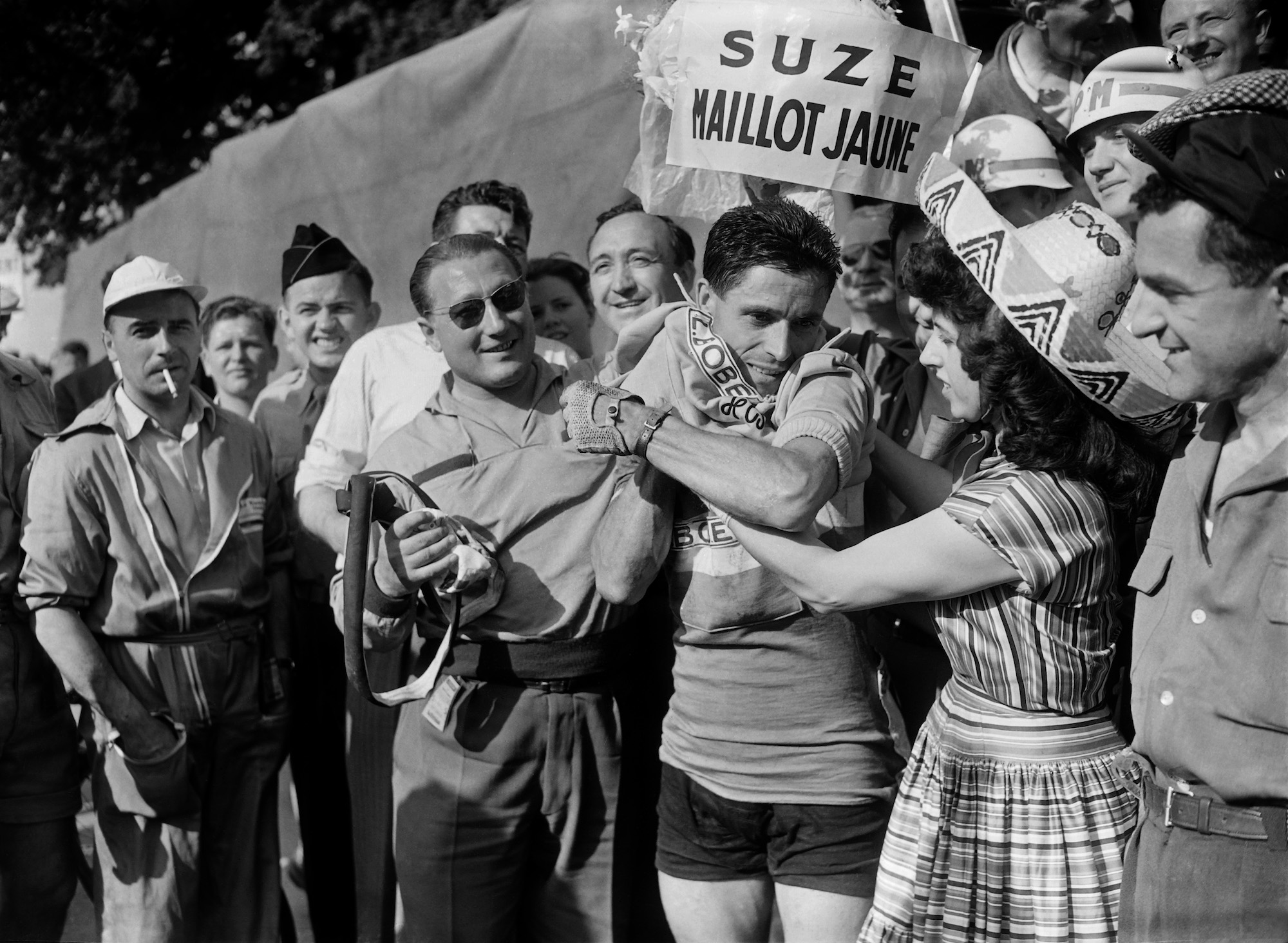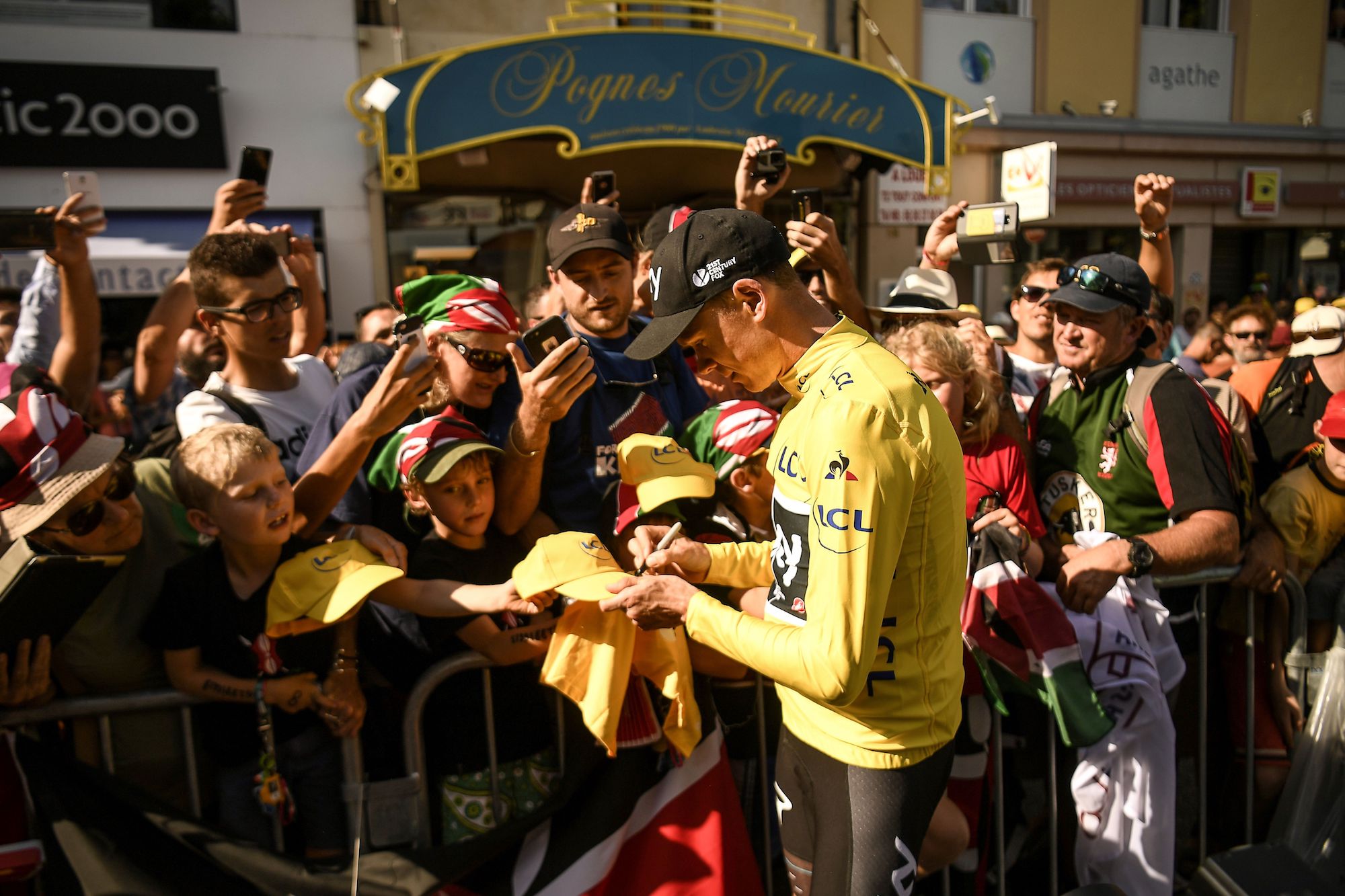100 years after the first yellow jersey, what makes it one of sport's most iconic trophies?
The Tour de France's yellow jersey is cycling's greatest prize. On the centenary of its inception Peter Cossins reflects on its symbolism and what makes it stand apart

Soon after I started working at Cycling Weekly in the early 1990s, the magazine received a set of Tour de France jerseys for test and review.
The polka-dot version of the King of the Mountains was swiftly bagged, the green and white jerseys were claimed soon after, but nobody was interested in what was at that time a quite orangey yellow jersey generally associated with being on the shoulders of five-time champion Miguel Indurain.
It would, I thought, be the perfect summer replacement for the Dayglo yellow jacket that I wore when riding to the office and back. A couple of days later, I’d just arrived for work resplendent in the jersey when a voice bellowed out, "You can’t wear that, Cossins. You haven’t won the Tour de France." Initially, I laughed along with what I assumed was a joke.
>>> Subscriptions deals for Cycling Weekly magazine
"I’m not kidding. Unless you’ve at least led the Tour, you shouldn’t be seen dead in that jersey," my colleague asserted.
That was the last time I wore it. That evening I washed it and put it in a drawer. Twenty-five years later, it’s still there, pristine, almost unused, suffused with the scent of a Laura Ashley Summer Breeze drawer liner.
I can’t draw a direct link between that incident and my decision to set about writing a book about the yellow jersey to coincide with the centenary of its inception, but it did highlight its exclusivity and uniqueness as a sporting prize.
Get The Leadout Newsletter
The latest race content, interviews, features, reviews and expert buying guides, direct to your inbox!
During most seasons, the only cyclist I can recall seeing in a yellow jersey was the Tour leader. Yes, there are banners, bunting, caps, t-shirts and just about every other type of accessory in yellow, but almost never a jersey. One French journalist told me that it’s actually forbidden to wear the maillot jaune. "It belongs to the Tour leader, and him alone. He’s like Louis XIV, the Sun King, reincarnated in a cycling jersey," he affirmed.
>>> Cycling Weekly is available on your Smart phone, tablet and desktop
It initially struck me that there might be some merit in a book on the jersey when reading Cyrille Guimard’s evisceration of the final days of Thomas Voeckler’s long spell in yellow during the 2011 race.
According to the legendary team manager, Voeckler became so intoxicated by the power, both physical and hierarchical, that leading the Tour instilled in him, that he started to believe he could do almost anything on the bike and didn’t need to listen to anyone’s counsel. The Frenchman, who dropped from race leader three days from Paris to fourth when the Tour entered the French capital, had, argued Guimard, become "his own directeur sportif" and ridden in tactically the opposite way to how he should have.

This tale of how the jersey can motivate and madden formed part of my initial pitch to Tim Broughton, the editor at Yellow Jersey Press — the obvious first choice. Instead of yes or no, Tim’s first response was, "I can see the cover already." The image that now adorns the printed version is precisely in line with what Tim described to me that day.
Undistinguished origins
Yet, as is often the case when progressing slowly from the initial proposal to the final published version, my research took me in many unexpected directions. For instance, in trying to get to the bottom of the convoluted story about the maillot jaune’s inception, which is essentially buried with the characters involved, it became apparent that the yellow jersey meant very little to riders, fans and even the race organiser for several seasons. This stemmed partly from general ambivalence and even dislike for the colour yellow. Associated with treacherous behaviour — Judas is often depicted wearing a yellow cloak in medieval paintings — cowardice, prostitution and cuckolds, its first appearance on the shoulders of Eugène Christophe on the morning of July 19, 1919 triggered gibes from his rivals rather than any sense of respect.
Yet, over subsequent decades, as the jersey’s status and influence has increased to an almost incomparable level, yellow has also become more favourably regarded, its prestige also boosted by the brilliant flamboyance of Brazil’s football team. This is particularly apparent in France, where the Tour and its defining symbol signal the arrival of the heat of summer, of the holiday season, of memorable family moments, often including a day watching the race, hoping for a glimpse of the rider in the fabled tunic. At the same time, the term maillot jaune has become part of common parlance, often used to describe leaders in the business, political and other spheres.

Enduring prestige
Initially derided and often sullied by the dirty antics of some who have worn it, the yellow jersey’s cachet has meant that its reputation has not been tainted by association. Although questions are often asked of the rider who claims it, often because he is seen as a figurehead for the whole sport, the maillot jaune has retained an iconic symbolism.
"I think one of the interesting things about the yellow jersey is that it is emblematic of the Tour and not necessarily of the winner," Michel Mathieu, director-general of jersey sponsors LCL, told me.
The French bank, which shares the Tour’s yellow and blue colours, has sponsored the jersey since 1987, and currently invests €10 million a year to maintain a link that ensures that its branding appears on the Tour leader’s chest every day. "It’s a great story, a love affair that continues to thrive," said Mathieu of an investment that guarantees an immense profile and is all but risk-free, which makes it almost unique in cycling.
Taking a wider perspective and comparing it with other iconic sporting prizes, the yellow jersey still stands apart. As the emblem of a race rather than a team, it doesn’t foster passionate and unquestioning support among fans. Equally, although it is often likened to the green jacket awarded to the winner of the US Masters golf tournament, it has a more exalted status, because the winner has to fight for it and defend it for such an extended and usually very intense period, rather than being presented with it when the event is won. The victor may not be widely loved or idolised, but tends to be hugely admired and set apart by his radiant garb as cycling’s Sun King.

Race leader and target
Of the many riders I spoke to who have worn yellow, the one who stands out is 94-year-old Antonin Rolland. The interview came about by chance. I'd gone to the 2018 Dauphiné with the primary goal of interviewing Tour director Christian Prudhomme, but had previously noted that Rolland, who is the oldest surviving maillot jaune, had been born and brought up near Mâcon, in the Saône valley, close to one of the stage finishes. An internet search revealed the existence of Cycles Antonin Rolland in Jassans-Riottiers. I called in and discovered the owner was now Rolland's grandson, Cyril, who arranged for me to meet his grandfather the next morning in the shop.
The sprightly Frenchman raced against Coppi, Bobet and Anquetil and could - he insisted he would! - have won the 1955 race if he hadn't been hit by illness in the Pyrenees, having held the lead for more than a week.
Like all those who have led sport's greatest race, Rolland spoke of the intense pressure he felt, which became so all-consuming that the only place he could escape it was when he was inside the peloton. Yet, even then he was a target, unmistakeable in yellow, the rider every other member of the pack around him wanted to knock off his perch.
"Having the yellow jersey does change your status within the bunch. It's like becoming the king of this little planet that is the Tour de France. You find yourself with a little bit more space in the bunch because the riders have great respect for the yellow jersey. But they all want it from you," he said.
Coping with this pressure has become one of the essential characteristics of every Tour champion, and arguably the one thing that they all share. For Rolland, the master in this domain was Louison Bobet, who won three consecutive Tours in the mid-1950s. More recently, Geraint Thomas did so taking every day as it came and remaining in what he described as his "bubble".
For my mind, no one can match Chris Froome for his ability to remain seemingly stress-free. Unflappable and courteous even when difficult questions were being asked of him and his team, Froome never wavered from the focus on his ultimate goal. The fact that prior to his terrible crash he was the favourite for a fifth title despite being without a win for more than a year, highlights how crucial experience is when it comes to wearing and winning the yellow jersey.
This article originally appeared in the print edition of Cycling Weekly, on sale in newsagents and supermarkets, priced £3.25.
'The Yellow Jersey' by Peter Cossins, published by Yellow Jersey Press, RRP £25, out now.

Thank you for reading 20 articles this month* Join now for unlimited access
Enjoy your first month for just £1 / $1 / €1
*Read 5 free articles per month without a subscription

Join now for unlimited access
Try first month for just £1 / $1 / €1
Peter Cossins has been writing about professional cycling since 1993, with his reporting appearing in numerous publications and websites including Cycling Weekly, Cycle Sport and Procycling - which he edited from 2006 to 2009. Peter is the author of several books on cycling - The Monuments, his history of cycling's five greatest one-day Classic races, was published in 2014, followed in 2015 by Alpe d’Huez, an appraisal of cycling’s greatest climb. Yellow Jersey - his celebration of the iconic Tour de France winner's jersey won the 2020 Telegraph Sports Book Awards Cycling Book of the Year Award.
-
 Save £42 on the same tyres that Mathieu Van de Poel won Paris-Roubaix on, this Easter weekend
Save £42 on the same tyres that Mathieu Van de Poel won Paris-Roubaix on, this Easter weekendDeals Its rare that Pirelli P-Zero Race TLR RS can be found on sale, and certainly not with a whopping 25% discount, grab a pair this weekend before they go...
By Matt Ischt-Barnard
-
 "Like a second skin” - the WYN Republic CdA triathlon suit reviewed
"Like a second skin” - the WYN Republic CdA triathlon suit reviewed$700 is a substantial investment in a Tri Suit, and it is, but you’ll definitely feel fast in it
By Kristin Jenny